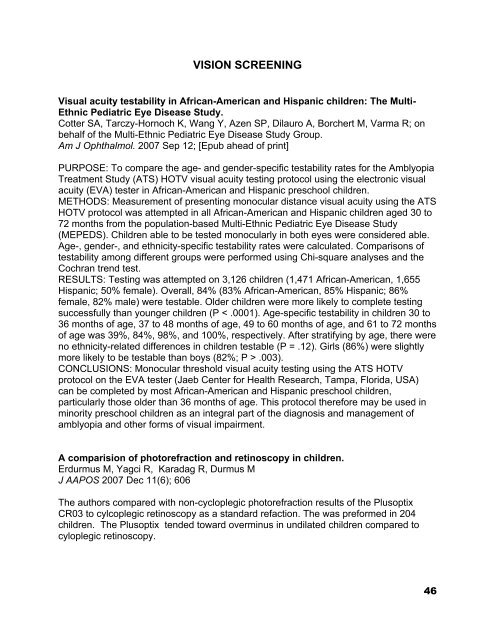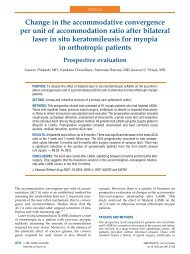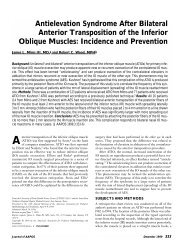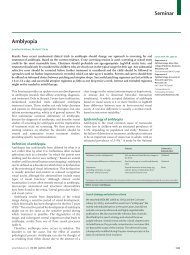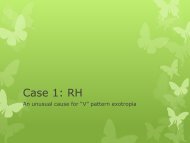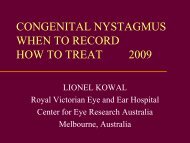What's new AAPOS 2008 - The Private Eye Clinic
What's new AAPOS 2008 - The Private Eye Clinic
What's new AAPOS 2008 - The Private Eye Clinic
Create successful ePaper yourself
Turn your PDF publications into a flip-book with our unique Google optimized e-Paper software.
VISION SCREENING<br />
Visual acuity testability in African-American and Hispanic children: <strong>The</strong> Multi-<br />
Ethnic Pediatric <strong>Eye</strong> Disease Study.<br />
Cotter SA, Tarczy-Hornoch K, Wang Y, Azen SP, Dilauro A, Borchert M, Varma R; on<br />
behalf of the Multi-Ethnic Pediatric <strong>Eye</strong> Disease Study Group.<br />
Am J Ophthalmol. 2007 Sep 12; [Epub ahead of print]<br />
PURPOSE: To compare the age- and gender-specific testability rates for the Amblyopia<br />
Treatment Study (ATS) HOTV visual acuity testing protocol using the electronic visual<br />
acuity (EVA) tester in African-American and Hispanic preschool children.<br />
METHODS: Measurement of presenting monocular distance visual acuity using the ATS<br />
HOTV protocol was attempted in all African-American and Hispanic children aged 30 to<br />
72 months from the population-based Multi-Ethnic Pediatric <strong>Eye</strong> Disease Study<br />
(MEPEDS). Children able to be tested monocularly in both eyes were considered able.<br />
Age-, gender-, and ethnicity-specific testability rates were calculated. Comparisons of<br />
testability among different groups were performed using Chi-square analyses and the<br />
Cochran trend test.<br />
RESULTS: Testing was attempted on 3,126 children (1,471 African-American, 1,655<br />
Hispanic; 50% female). Overall, 84% (83% African-American, 85% Hispanic; 86%<br />
female, 82% male) were testable. Older children were more likely to complete testing<br />
successfully than younger children (P < .0001). Age-specific testability in children 30 to<br />
36 months of age, 37 to 48 months of age, 49 to 60 months of age, and 61 to 72 months<br />
of age was 39%, 84%, 98%, and 100%, respectively. After stratifying by age, there were<br />
no ethnicity-related differences in children testable (P = .12). Girls (86%) were slightly<br />
more likely to be testable than boys (82%; P > .003).<br />
CONCLUSIONS: Monocular threshold visual acuity testing using the ATS HOTV<br />
protocol on the EVA tester (Jaeb Center for Health Research, Tampa, Florida, USA)<br />
can be completed by most African-American and Hispanic preschool children,<br />
particularly those older than 36 months of age. This protocol therefore may be used in<br />
minority preschool children as an integral part of the diagnosis and management of<br />
amblyopia and other forms of visual impairment.<br />
A comparision of photorefraction and retinoscopy in children.<br />
Erdurmus M, Yagci R, Karadag R, Durmus M<br />
J <strong>AAPOS</strong> 2007 Dec 11(6); 606<br />
<strong>The</strong> authors compared with non-cycloplegic photorefraction results of the Plusoptix<br />
CR03 to cylcoplegic retinoscopy as a standard refaction. <strong>The</strong> was preformed in 204<br />
children. <strong>The</strong> Plusoptix tended toward overminus in undilated children compared to<br />
cyloplegic retinoscopy.<br />
46


